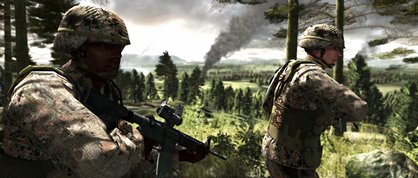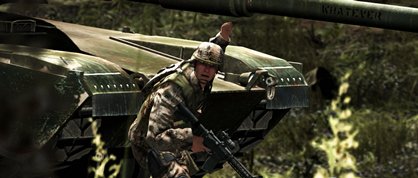Operation Flashpoint 2: Dragon Rising
It’s going to be a bumpy ride
There is one question to ask, one question to answer even before the demonstration begins. One question that almost defines the development of Operation Flashpoint 2. “Can you do that?” We point at the incredible rendered scenes that the British developers, Codemasters, have made available to the press. The extraordinary images of soldiers under fire, of helicopters approaching their landing zones, of massed infantry and armour striking forward. The frankly unbelievable postcards from the future that you can now see spread across these very pages. Brant Nicholas, Flashpoint 2’s Senior Producer, doesn’t even blink. “Yeah. Of course.”
Operation Flashpoint 2: Dragon Rising is the sequel to the best soldier sim ever created. It’s a game being built to exacting specifications by military obsessives, to simulate the authentic behaviour of battle-hardened troops and push gaming machines to their limits. Everything from the interiors of vehicles to the bolts on the lowliest of assault rifles has been rigorously researched and meticulously recreated. The background story is a plausible tale of war for oil on a tiny island claimed separately by Russia, China and Japan. The missions are excerpts from war games played by former military experts in a simulated conflict between China and the US. It’s a game built on an almost embarrassing level of detail.

It’s a moon shot for Codemasters – a game that will look, sound and play a generation ahead of the competition. The geography, all 220-odd square kilometers of it, includes rolling hills, forests, swamps and an extinct volcano to run around in. The dynamic environmental systems include day and night cycles, weather and accurate physics. Operation Flashpoint 2 is a game long in the planning, long in the making, and long, oh-so-long awaited. One problem: right now, all they have to demonstrate their ambition are target renders (based at least on the actual art assets created for the game) and a very, very early prototype. For now, we have to take their word for it.
For the story of Flashpoint 2, you need to speak to Andrew Wafer. It’s a story that begins in 2001, when he was working on the original Operation Flashpoint. A vast and uncompromising simulation of warfare between Russia and the US, it went on to sell over two million copies. From its first moments, you could tell that it was different. Rather than appearing at the edge of combat, straight into the action, you’d often take a truck, or hike to the frontline. Instead of a great big pool of health, and a ready supply of health-kits, one bullet – sometimes from a sniper nestled in a bush a kilometer away – would end a mission. Andrew is exactly right when he says “players of the original Operation Flashpoint had two reactions to that moment. Either they turned it off immediately, never to play again, or they fell completely in love.”

The original Flashpoint was developed with Bohemia Interactive, developers based in the Czech Republic. After its success, Bohemia and Codemasters both wanted to produce a sequel, but had “different ideas of where the sequel should go.” Andrew spent the next few years touring the globe. “I went everywhere, all over the world, looking for a team to make Operation Flashpoint 2.” No one had the technology. No one had the vision. No one understood the raw attention to detail and endless geography a second Flashpoint game would need. So, in 2005, after years of fruitless searching, the executives at Codemasters made a decision. They were going to do it themselves.
Sign up to the GamesRadar+ Newsletter
Weekly digests, tales from the communities you love, and more


